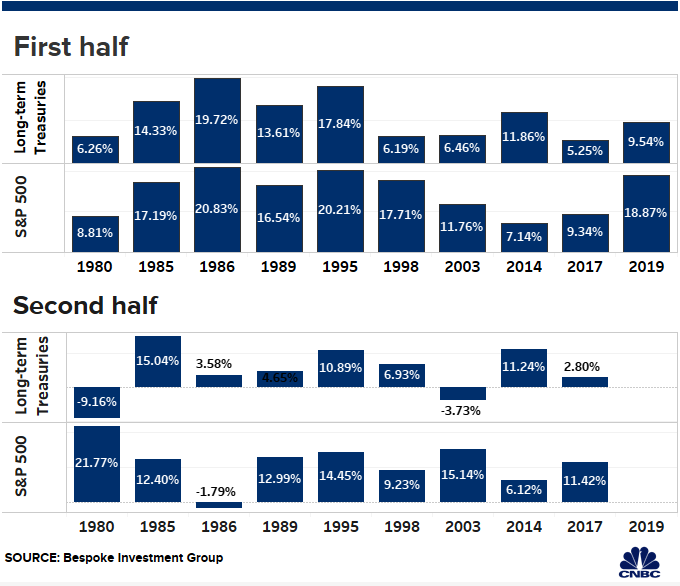
Something unusual is happening in financial markets, and it could mean more gains lie ahead for stocks, if history is any indication.
The S&P 500 and long-term bonds are both up more than 5% to start off 2019, marking just the 10th time since 1980 that stocks and bonds kicked off a year on such a strong note, according to data from Bespoke Investment Group. The data also shows the S&P 500 averages a gain of 11.3% when stocks and bonds get off to such a hot start.
Sharp gains in both equities and fixed income are unusual since rising bond prices — or declining yields — are usually seen as a signal that an economic slowdown looms ahead. Bonds are seen as a safe haven in times of economic turmoil. Stocks, meanwhile, usually produce much higher returns than bonds when the economy runs smoothly.
That’s why they usually don’t trade together.
“While the relationship between the performance of equities and US treasuries has changed over time … positive equity performance has coincided with weaker performance in treasuries and vice versa,” Bespoke said in a note Monday. “This year has bucked that trend.”
Hopes for Fed rate cut
But this year is now all about the Federal Reserve. Investors have been plowing money into both stocks and bonds in bets the Federal Reserve will reverse on monetary policy, bringing rates down to boost the economy.
The Fed came into 2019 expecting to raise rates twice before bringing that forecast to zero. Now, investors are expecting the Fed to start cutting rates as early as next month after the Fed said last week it is ready to “act as appropriate” to sustain the current economic expansion.
Traders work on the floor of the New York Stock Exchange.
Brendan McDermid | Reuters
Bonds have risen all year “despite a stock market which continues to trend higher. The stock market appears optimistic about the future of this recovery, whereas the bond market is acting increasingly nervous,” said Jim Paulsen, chief investment strategist at The Leuthold Group, in a note. Determining which market is right “is a tough call, but for equity investors we continue to lean toward the view that what doesn’t kill you will likely make ‘the stock market’ stronger.”
The trade war could also be influencing the correlation between the two markets. Stocks are still holding out hope there will be a trade deal, while bonds are reflecting the damage already wrought by the tariffs in place, and perhaps a greater fear an agreement may take longer to hatch.
President Donald Trump and Chinese President Xi Jinping are scheduled to meet at this week’s G-20 in Osaka, Japan. Investors expect the two leaders to signal progress is being made on the U.S.-China trade talks that stalled last month amid tariff hikes from both countries.
Treasury Secretary Steven Mnuchin told CNBC’s Hadley Gamble there is a “path ” for the two sides to complete a trade deal.
Recession risk
Neither a Fed rate cut nor progress on the U.S.-China trade front are a sure thing, however. The Fed could reverse course on cutting rates if U.S. economic data improves between now and its July 10 meeting.
Recent economic data has been lackluster at best. If it’s just a soft patch that can be fixed by slightly lower rates, then the run in both markets at the same time will be justified. But if the economy turns into a recession, bonds may keep going higher while stocks fall.
U.S. consumer confidence dropped to its lowest level in nearly two years in June, The Conference Board said Tuesday. IHS Markit reported last week that U.S. manufacturing growth slowed down to its slowest pace in nearly a decade. U.S. jobs grew by just 75,000 in May, widely missing expectations. Data sets like these, along with lingering trade tensions, forced the Fed to pivot away from its two-rate-hike forecast.
But John Davi, chief investment officer at Astoria Portfolio Advisors, notes there is a lot of time for economic data to improve before the Fed’s next meeting.
“I don’t think it’s a done deal that the Fed is going to cut rates in July,” Davi said. “If you get a resolution between Trump and China and the data is OK and the market keeps rallying, why would the Fed need to cut? The whole point of cutting is the data is weakening. If we get a resolution at the G-20 meeting and positive data, then the Fed doesn’t cut. Then, the market sells off.”
There is also, however, the possibility that talks between Trump and Xi at the G-20 fall through, heightening trade-war fears once more.
Trump said on Wednesday that a deal with China was possible but noted he is “very happy with where we are now. ” Trump has also said that he is willing to slap tariffs on $300 billion worth of Chinese goods. The U.S. has already imposed tariffs on more than $250 billion worth of Chinese imports.
Art Hogan, chief market strategist at National Securities, said stocks and bonds can continue to rise in tandem “barring any disastrous news on trade.”
“But what could be different is, if this administration contends that being tough on China is one of the best cards to play in the 2020 election, that will drag on longer and we’ll get an additional tranche of tariffs.”

